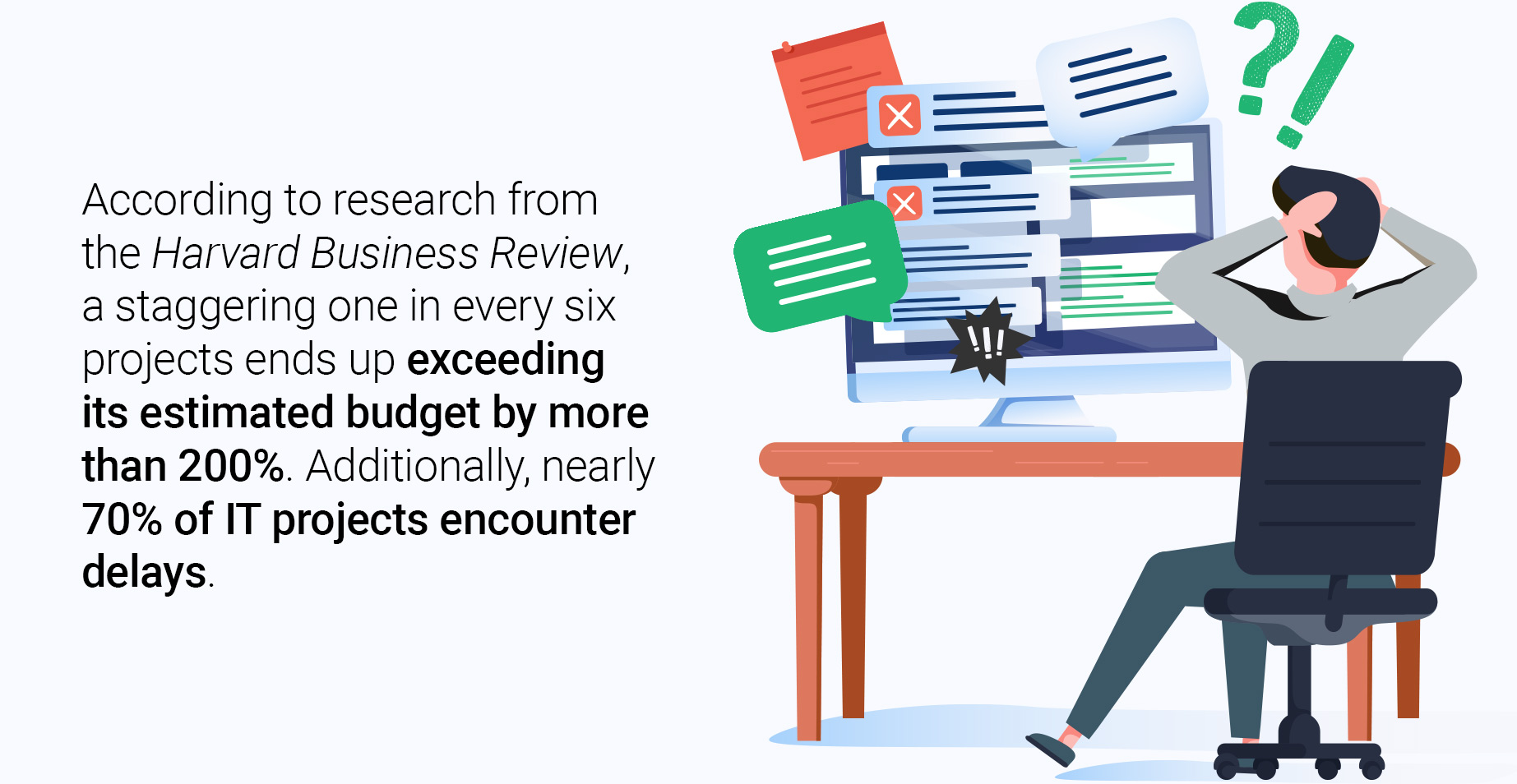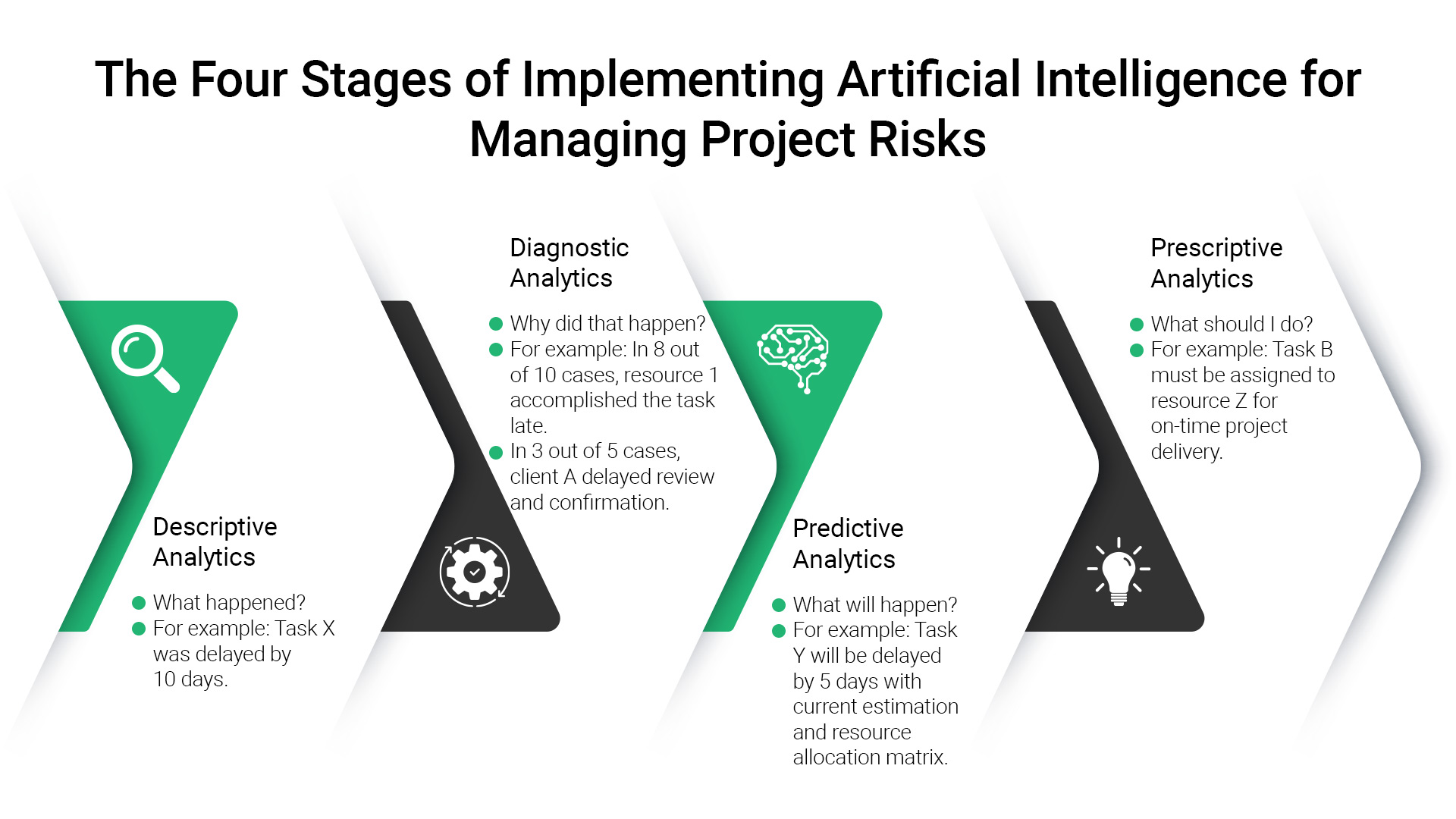
Managing project risks. It isn’t an exciting or pleasant topic, you think? As a project leader, your foremost responsibility is to anticipate and mitigate potential pitfalls that could derail your projects. It's about facing the uncomfortable reality: what could possibly go wrong?
Embracing risk identification at the outset of your project planning transforms the unexpected into manageable hurdles. It's proactive, strategic, and essential. By proactively pinpointing potential roadblocks, you'll be equipped to address them before they snowball into full-blown crises. But how do you work towards resolving the unknown? It is here that smart technology solutions like artificial intelligence (AI) play a critical role. AI algorithms can identify patterns and correlations that you might overlook. This proactive approach enables you to anticipate project risks before they escalate, allowing for timely interventions and strategic adjustments. Moreover, AI-powered predictive analytics provide actionable insights that empower you, the decision-makers, to allocate resources more effectively, optimize project timelines, and enhance overall project performance.
In this article, we will discuss the strategies and process of managing project risks so you can identify and track risks on your projects. Additionally, we will also shed light on how AI-powered solutions help you make data-driven decisions to minimize disruptions and keep your projects on track.
Why Is Managing Project Risks Critical?
Project failures can stem from many factors, ranging from ambiguously defined project scopes to inadequate risk management strategies, inexperienced project leadership, and ineffective communication channels. These failures can undoubtedly take a heavy toll on organizations, resulting in unforeseen costs, operational disruptions, regulatory non-compliance, dissatisfied customers, and a loss of competitive edge.
Studies indicate a concerning trend, with a staggering 63% of companies experiencing project failures. Notably, the probability of success diminishes as project costs escalate. Studies point out that the likelihood of success for initiatives costing between $1 million and $3 million is 34%, while the likelihood for ventures costing more than $10 million is only 7%. Even among completed projects, nearly half fall short of meeting their time, budget, and quality objectives. But why do these failures occur?
 Researches underscore a direct correlation between project complexity and failure rates, revealing that more intricate projects are predisposed to higher failure probabilities. Despite this complexity, organizations often neglect the process of managing project risks until issues emerge during project execution. Initial risk assessments are frequently relegated to the sidelines, only to be hastily addressed when problems arise, aggravating chaos and magnifying the impact of risks.
Researches underscore a direct correlation between project complexity and failure rates, revealing that more intricate projects are predisposed to higher failure probabilities. Despite this complexity, organizations often neglect the process of managing project risks until issues emerge during project execution. Initial risk assessments are frequently relegated to the sidelines, only to be hastily addressed when problems arise, aggravating chaos and magnifying the impact of risks.
So, how can you ensure a more proactive approach to managing project risks? Modern practices for managing project risks are evolving towards a quantitative, data-driven approach. This progressive methodology relies on sophisticated analytical capabilities to assess projects. By leveraging predictive analytics, this approach scrutinizes project characteristics and complexity factors to gauge the likelihood of success.
Imagine having the foresight to anticipate potential risks and pinpoint precisely where immediate interventions are needed to mitigate risks in ongoing projects or programs, regardless of their stage in the lifecycle. Advanced analytical solutions promise to revolutionize project risk assessment, offering unparalleled insights and actionable strategies to enhance project outcomes. By identifying and addressing potential issues early on, it can fundamentally alter the project landscape, ensuring smoother execution and minimizing undesirable developments. Let’s look at some of the common project risks.
Managing Project Risks: Common Risks You Encounter
Remember, even the most meticulously planned project faces unforeseen challenges. Fortunately, understanding and proactively managing project risks can significantly increase your chances of success. Here's a breakdown of the ten most common roadblocks you'll encounter, along with strategies to keep your projects on track:
Technology Risk: With the rapid evolution of technology, projects face the daunting task of keeping pace with new advancements while safeguarding against threats to data security, compliance, and information integrity. The acquisition of new software and the need for ongoing personnel training further compound these risks. While managing project risks, carefully evaluate new technologies and ensure compatibility with existing systems.
Communication Risk: Effective communication is the cornerstone of successful project execution. Failure to maintain clear and timely communication channels among stakeholders and key team members can lead to data loss, misinformation, and project disruptions. Stakeholder engagement and regular meetings with the team play a crucial role in managing project risks.
Scope Creep Risk: Uncontrolled changes to project scope can inflate costs and introduce delays, jeopardizing project success. Clearly define the project scope at the outset and establish a change management process that requires approval for any modifications.
Cost Risk: Mismanagement or shortages of project funds can impede progress and force difficult trade-offs between budget constraints and operational requirements. Managing project risks associated with cost involves meticulous cost estimation, maintaining a buffer for unforeseen expenses, and closely monitoring project expenditures.

Operational Risk: Poor implementation of critical operations and processes poses a direct threat to project continuity and success. Whether stemming from IT system failures, human error, or financial constraints, operational risks require diligent monitoring and proactive intervention.
Skills Resource Risk: Overreliance on internal staff and gaps in skill proficiency can disrupt project timelines and inflate costs. Managing project risks here involves a skills gap analysis to identify shortcomings and implement training programs or strategic recruitment to bridge the gap.
Performance Risk: When projects fail to deliver intended results, performance risk emerges, impacting overall business outcomes and competitiveness. Overcoming project risks associated with performance involves establishing clear and measurable performance indicators (KPIs) and course-correcting measures to keep the project on track.
Market Risk: Fluctuations in market conditions, including competition, commodity prices, and interest rates, pose significant challenges to project viability and profitability. Robust market analysis and adaptive strategies are crucial to navigating these uncertainties.
It's crucial to recognize that not all risks are immediately apparent, complicating efforts to identify and mitigate them effectively. Furthermore, these challenges can be combined by conflicting objectives and priorities among stakeholders, along with the persistent pressure to deliver projects quickly and within tight budgets.
The outcome of these dynamics often leads to projects burdened with lofty expectations but ultimately falling short of success. Such projects consume valuable time, resources, and capital without yielding the desired outcomes, highlighting the importance of managing project risks proactively. To overcome these challenges, consider leveraging predictive analytics and forecasting the success of your projects. How, you ask?
Can Predictive Analytics Help in Managing Project Risks?
Yes! Unlike relying solely on intuition or benchmarking, AI-driven predictive analytics employ a quantitative, data-driven approach to analyze key projects and organizational attributes. Doing so can help you identify projects that might be failing. Wouldn't avoiding the costs of late or poorly delivered projects, or even outright failures, be beneficial?

Predictive intelligence-enabled solutions conduct a thorough evaluation of the inherent risks and complexities associated with the projects. To achieve this, a comprehensive approach is adopted, encompassing various methodologies:
- Key project team members and stakeholders are engaged in structured assessments, supplemented by a meticulous review of essential project artifacts such as plans, reports, and logs.
- Draws insights from historical project data, analyzing both the hard data from your project or task management software and context-sensitive feedback from your stakeholders.
- The outputs from the assessments and project data are amalgamated to provide a comprehensive view of project risks. This stage identifies areas where control and governance enhancements can be implemented to manage project risks and improve project outcomes.
- Provides reports that are designed to offer practical recommendations and prioritize actions aimed at addressing or preventing identified project risks.
Predictive analytics can significantly safeguard return on investment (ROI) and prevent expensive overruns in intricate projects by effectively managing delivery risks and enhancing overall project performance. Consequently, such projects can be completed in a timely and efficient manner despite their complexity and high-risk nature.
What’s the Way Ahead?
Managing project risks isn't about wishful thinking or blind optimism; it's about strategically preparing for the inevitable challenges that threaten to derail your project. By embracing a data-driven approach and leveraging the power of AI-powered predictive analytics, you can transform yourself from a passive observer to a proactive guardian of your project's success with precision and confidence.
Managing project risks often requires using a proficient and effective project solution. TrueProject, a predictive intelligence solution for project health and performance, stands out as a potential solution to address such challenges, offering capabilities and efficiency to manage project risks. The solution evaluates your organization's knowledge base, operational behaviors, and processes against a repository of successful and challenged projects. By analyzing both people and procedural aspects of projects, TrueProject identifies areas requiring attention, enabling proactive measures to be taken before issues escalate. Also, TrueProject empowers you, the project leaders, with advanced alerts for managing project risks on time, thereby averting setbacks that could jeopardize your project success, organizational performance, and professional advancement.
Don't wait for disaster to strike; take control, identify potential risks, and implement effective mitigation strategies today. The future of your project, and potentially your organization's bottom line, depends on it.
 About the Author:
About the Author:
Nivedita Gopalakrishna is a content marketing specialist within the TrueProject Marketing team with extensive experience in blog writing and website content creation across diverse industries. Nivedita’s proficiency in crafting engaging blog posts and informative website content is a testament to her years of experience. Beyond her prowess in written communication, Nivedita has a knack for creating visually appealing static graphics that have played a pivotal role in expanding TrueProject's marketing efforts. Through thoughtful design choices, she has helped convey the essence of the brand and captivate audiences effectively. Outside the professional sphere, Nivedita is a trained classical singer and a fitness enthusiast, embodying creativity and wellness in and out of the office.
Endnotes:
- Sarma, Puspanjali. “Mitigating Project Risks with Predictive Analytics.” LinkedIn, April 09, 2019. https://www.linkedin.com/pulse/mitigating-project-risks-predictive-analytics-puspanjali-sarma/
- Chaurasia, Niharika. “Project Risk Analysis: Tools, Templates & Best Practices.” Sprintzeal, June 12, 2023. https://www.sprintzeal.com/blog/project-risk-analysis
- “9 Project Management Challenges and How to Overcome Them.” Kissflow, December 21, 2023. https://kissflow.com/project/project-management-challenges/
- “10 Common Project Risks (Plus the Steps To Solve Them).” Indeed, October 13, 2023. https://www.indeed.com/career-advice/career-development/project-risks
- Deloitte. “A Five-Stage Approach to Predictive Project Analytics.” CIO Journal. Wall Street Journal, (n.d.). https://deloitte.wsj.com/cio/a-five-stage-approach-to-predictive-project-analytics-01665017966





